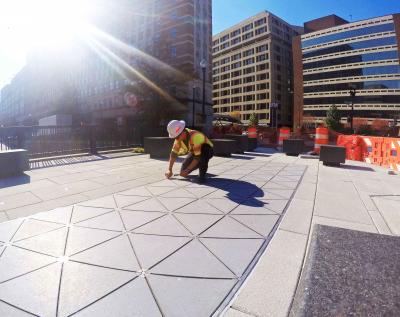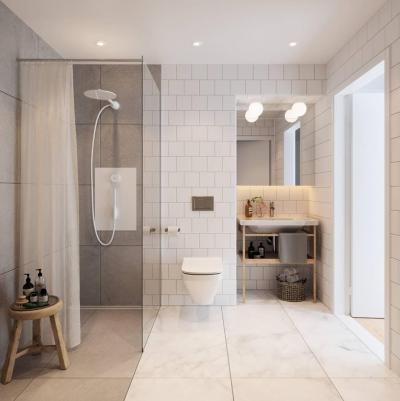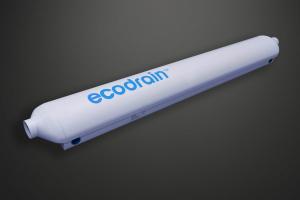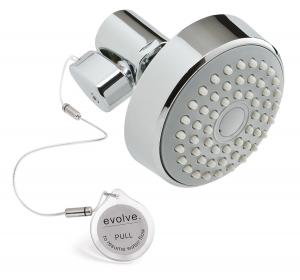
Smart Roads
Roads. To an environmentally minded person, they’re something of a menace. Too often, they require bulldozing through natural habitat and laying down black asphalt that absorbs sunlight and further warms the planet. But smart highways of the future might make roads a bit better.
They could harness solar power:
In late December, China launched its first solar road, to test whether its roadway system could do double duty
by generating power from the sun.
The 1-km stretch of expressway near the city of Jinan is lined with photovoltaic tiles, sandwiched between a layer of insulation on the bottom and transparent concrete on top.
While the country’s state-run CCTV boasts that it’s the world’s first solar-panel highway, the French village of Tourouvre-au-Perche opened 1-km solar road in late 2016, with the aim of testing its energy-generating capabilities over two years.
In the US, Solar Roadways has an ongoing IndieGoGo campaign to fund its company’s research and development for domestic solar roads, plus grants from the US Department of Transportation. The company installed its solar road in an Idaho parking lot in 2011 and is currently assessing viability for a larger solar roadway system. Its roads are made of solar panels under textured, fire-and shatterproof glass, with a heating element to melt snow and ice, and LED lights for road markings.
Outlook:
Critics point out that solar roads aren’t very efficient—flat tiles mean they can’t harness the sun as well as the angled panels you see on the roof. And the glass or transparent concrete coating could prove slippery in adverse weather conditions. Plus, while the cost of solar panels keeps nosediving, tempered glass or transparent concrete is pretty much guaranteed to cost a lot more than asphalt in the long-term.
But the people at Solar Roadways say its testing shows that even accounting for flat-tile performance, replacing all US paved roads with solar roads could produce over three times the electricity the entire country uses. Plus, its solar road tiles are textured, solving the slippery road issue.
“A Solar Roadway offsets its cost over time,” the company notes on its website. “No more contributing to the climate crisis. No more dependency on fossil fuels. No more power outages. ... Safer driving conditions. Far less pollution. A new secure highway infrastructure that pays for itself. A decentralized, self-healing, secure power grid.”
They could generate electricity:

Could the mere act of driving on a road help provide energy to our communities? Sure, say scientists around the world working with piezoelectric materials. Roads made with piezoelectrics (piezo is Greek for “squeeze” or “press”) convert the pressure and vibrations from car or foot traffic into usable energy.
While it might sound like a pie-in-the-sky option to the layperson, the technology has already been proven on a smaller scale. UK-based Pavegen has installed over 150 piezoelectric walkways, including one in Washington, DC. When pedestrians walk on it, the DC walkway generates energy that turns on the LED street lamps overhead.
In mid-2017, California invested $2.3 million into two piezoelectric lengths of road. The first project, conducted by the University of California–Merced, will scatter tiny piezoelectric generators onto a 200-foot section of road on campus. The second project, from San Jose-based Pyro-e, will test a half mile of piezoelectric highway with the goal of having it power 5,000 homes.
Says Mike Ward of the California Energy Commission, which is funding the two California programs: “These pilot-scale programs will assess the technical and economic feasibility of piezoelectric systems including power output, life expectancy, durability, cost, and marketing potential.”
Outlook:
Still unknown, as piezo-electrics have never before been tested at this scale. Ward says the results from the two California projects “will help determine the feasibility of conducting future large-scale demonstrations on highways and streets.”
If successful, piezoelectrics could be a real win for the Earth and its climate.
Drive Greener Now
Greener roads won’t solve the massive amount of emissions from driving anytime soon. For that, everyone needs to reconsider their driving habits.
Drive less: The best way to cut your climate and environmental impact from driving is to not drive at all. Walk and bike whenever possible, or carpool or take public transportation. Most public systems have apps available to help you plan your trip. And the increasingly popular Waze app (iOS/Android) makes finding carpool buddies in your area easy.
Go electric: Powering a vehicle with electricity costs roughly the same as fueling one with $1/gallon gasoline, and it’s cleaner, according to Plug In America: Electric vehicles powered by our current coal-riddled grid produce 54 percent less carbon pollution than gasoline cars. If you’re worried about charging on long trips, a plug-in hybrid electric vehicle (PHEV) has a gas tank that kicks in when the battery runs out.
Consider biodiesel: Fill a diesel car up with biodiesel, a concoction of vegetable oil and alcohol, to get your driving emissions to zero. Or, you can convert your car to accept straight vegetable oil (SVO), too. Find a biodiesel station near you.
Smart Garages
As cars get greener and roads get smarter, garages are improving, too. Part of the attraction of low-emission electric and plug-in hybrid electric vehicles (EVs and PHEVs) is that they could provide renewable energy storage while they’re parked—and smart garages can help make that happen.
Solar power is, of course, available during the day. And in most places, the wind blows more strongly at night. So a conundrum engineers face over a switch to renewable energy is how to store that power for use when the sun isn’t shining or the wind isn’t blowing as much.
Enter smart garages.
Smart garages with vehicle-to-grid (V2G) capacity could pull small amounts of power from the batteries of the cars parked and plugged in inside them, sending that energy into the grid. Most garages are full during the day, as drivers go to work, and that’s also when energy use is at peak demand.
The National Renewable Energy Laboratory is currently testing a V2G smart garage on its campus. Likewise, the University of California–San Diego, with a grant from the California Energy Commission, is implementing a plan to test 50 V2G charging stations on campus.
Engineers from Tesla have expressed doubts as to whether the wear and tear on a car battery would make parking in a V2G garage economically viable for drivers in the long-term. But BMW and PG&E just completed an 18-month test of a 100-car V2G program in San Francisco, deeming the project a success. 98 percent of participants said they were satisfied with the program, which has moved on to a second phase of testing.
Smart Water Savers

Cape Town, South Africa, announced this winter that it was in crisis as its water supply is expected to dry up in mid-May. As the climate crisis hits the developing world first and worst, it’s critical that we all take steps to conserve water. While the devices below can’t replace smart homeowners who take steps to save water in their lives, they could help add on more water savings.
A Recirculating Shower: The average US shower uses 20 gallons of water. Orbital Systems aims to put the brakes on that water waste with its OAS Closed-Loop Shower (at right).
Instead of using a small pond’s worth of water, the OAS recirculates roughly 1.5 to 3.5 gallons of water, re-purifying it and adjusting pressure and temperature before it washes over you. At $3,599, however, the OAS may be too pricey for many people.
The Smarter Shower: If you’re installing a new shower and have some money to spare, you could consider the Kohler DTV Prompt with Eco-Mode Diverter ($399).
Designed to work with Kohler tub faucets and showerheads, the DTV Prompt is a digital interface that lets you customize your shower’s water pressure and temperature. The “warm-up” mode heats your water to your ideal temperature and then stops the shower until you’re ready to get in, saving water. And it includes a pause function that lets you quickly and easily stop the water flow for up to two minutes, after which your shower will resume just as you
set it.
 The device also includes a timer setting, to remind you to get out in a timely, water-saving manner.
The device also includes a timer setting, to remind you to get out in a timely, water-saving manner.
The Greywater Heater: The energy used to heat water in your home, including your shower, is the second largest cost driver of utility bills, according to the US Department of Energy. Now you can recover some of that wasted heat with the EcoDrain ($575). This device captures used hot shower water as it goes down the drain uses it to heat clean water before it exits your showerhead. 
The Smart Showerhead: For a lower-priced, lower-tech option, consider the Evolve line of low-flow showerheads, sold by Florida Eco Products and others. All Evolve showerheads and tub faucets exceed EPA WaterSense thresholds for water savings.
For a smarter shower experience, look for Evolve showerhead models featuring “ShowerStart TSV,” or a Thermostatic Shut-Off Valve ($39.99 to $54.99). While they do blast water while your shower is warming up, these showerheads have sensors that detect when the water has reached a comfortable 95 degrees—at which point, they will switch to a trickle, signaling they’re ready for you to climb in. You just pull the cord to resume full flow and begin showering.
 Some Evolve models allow you to switch to a trickle whenever you like, so you don’t use as much water while you’re soaping up.
Some Evolve models allow you to switch to a trickle whenever you like, so you don’t use as much water while you’re soaping up.
You can also purchase the Evolve ShowerStart TSV, an attachment that retails for $25.95 and screws in between the wall and the showerhead of your choice, giving it the same warm-up function as the Single Function and Roadrunner.
Smart Faucet: While most of the innovations for water savings seems to be around the shower, a few smart faucets may be coming to stores as well.
You might have seen infrared faucet models in public restrooms that automatically turn on when you put your hands underneath them, and turn back off again when you take your hands away. Now, you can have a faucet with that same function at home, with devices like the iTouchless EZ Faucet Adapter (from $46.64). The EZ Faucet isn’t a faucet at all, but an adapter you can screw on nearly any sink faucet to enjoy the water-saving feature.
The company says the EZ Faucet can save an average household 200 gallons of water a month. Kohler offers its DTV Prompt (see previous page) for tub faucets as well as showerheads. 
You might also find smart faucets with wireless capability and smart screens, like the Nomos from Fima Carlo Frattani. The Nomos has a touch screen that allows you to control temperature and pressure, and it also has a pause feature that heats up the water to the ideal temperature before it comes out of your tap.
However, it’s not yet clear whether the water savings of a faucet like the Nomos offsets its energy use when connected to the current power grid. And the fact that it’s wireless means it may be one to skip if you’re worried about EMF radiation.
Save water Now
You can curb your water use without fancy faucets and showerheads. Green America’s recent article, “13 Ways to Save 65+ Gallons of Water a Day” includes several tips to lower your water waste. The top savers we found are taking five-minute showers (a simple timer can help), fixing leaks in your home, and washing full loads of laundry and dishes.
In addition, conventional low-flow showerheads, toilets, and faucets offer water savings without complex gadgetry. Find green businesses offering smart and analog water-saving tools in the “Water Conservation” category at Green America’s GreenPages.org.
Smart Air Monitors
Green America has often recommended getting a Home Performance with ENERGY STAR audit, because this type of audit not only thoroughly points out energy leaks in your home but will also give you ways you can improve indoor-air quality. Now, new smart monitors can provide some of the same indoor-air monitoring 24/7.
The uHoo ($199) tracks airborne chemicals and particulate matter inside your home, letting you know when levels are too high for health. It also tracks carbon monoxide, ozone, CO2, humidity, and temperature.
In addition, it provides charts tracking your indoor air over time, so you can easily identify pollution sources and patterns. And it’ll send you alerts via a cell phone app if your levels are unhealthy.
The Foobot ($179) detects invisible air pollutants inside your home, letting you know which are occurring and in what quantities via an LED display. In particular, it looks at chemical pollutants and particulate matter, as well as temperature and humidity.
Like the uHoo, it provides charts tracking your indoor air over time, so you can easily identify pollution sources and patterns. And it will compare your indoor air to your geo-located outdoor air, letting you know if you’ll get some relief by opening the windows or not.
The Awair ($165) tracks dust, chemicals, CO2, relative humidity, and temperature. It’ll also send you personalized recommendations via an app for cleaning up the air inside your home.
You’ll need WiFi to set all three up and take advantage of all features. After setup, the Foobot will work offline. You’ll just forgo the feature that allows you to send data to the cloud and get back personalized recommendations. The uHoo turns off completely (including WiFi signal) when it’s not actively monitoring—which happens once every minute for ten seconds or less. But if you have hard-wired your internet for safety, neither it nor the Awair will work sans wireless.






